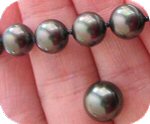|
|
| Home > Pearls > Shell |
| Amara�
South Sea Shell Pearls |
|

5
Which is real, which is
Amara?
The left is a natural Tahitian, to the right, a strand
of our black Amara Tahitian shell pearls. Same
beauty, 1% of the price.
|
Our Amara shell pearls are
the top of the line in quality, with an amazing layering
process using 19 -
23 layers. Top
of the line before
was 7x coating. |
If you've done some research, you'll see that a strand of
true South Sea white
pearls will cost you about $11,950 for a 16" strand of 8mm,
A grade, high luster
pearls. By comparison, our Amara's are available for under
$200.
Same
look, feel, weight and luster - why? Because
they use similar beads as those used for the true
cultured pearls, and then create a man-made nacre
from shell material. The man-made nacre is
then coated over and over, to replicate the way an
oyster applies nacre to the bead in true cultured
pearls.
We offer two beautiful colors, South Sea Whites
and Tahitian Blacks for for you to enjoy.
You may select the color of Amara�
shell pearl you are interested below to see our
necklace offerings:
|
|

You can view
more photos and shop Amara�
shell pearl necklaces.
|
|

South Sea Whites
An organic,
man-made pearl that rivals the
finest natural South Sea whites |

Tahitian Blacks
Beautiful
green overtone, with subtle, highly sought-after peacock
effect |
"The least
expensive manufacturing process for
imitation pearls uses plastic bead centers
formed by injection molding. Because of
their low cast, such imitations are
responsible for as much as 80 per cent of
the imitation pearl market. Their low
specific gravity, however, makes them less
desirable than those imitations with heavier
centers. This is particularly obvious when
plastic imitations are used in strands,
since these bead strands do not lay evenly
or move �naturally�.
The most
expensive imitation pearls manufactured in
Japan use central beads formed from shell.
They can be quite convincing in both
appearance and heft, and have been
variously called �shell pearls�, �imitation
cultured pearls�, and �man-made pearls.�"
- excerpts from
a previous edition of Gems and Gemology
magazine.
|
|
|